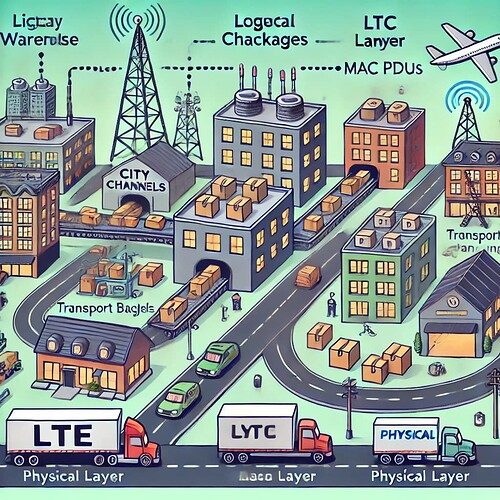This topic presents in a very simplified way all the main concepts that should be understood by those who know LTE.
LTE Downlink Channel Type Mappings
In LTE we have Downlink Physical Channels that transfer data across the air-interface and Downlink Transport channels that transfer data between the MAC and Physical layers. And we also have Downlink Logical channels that transfer data between the RLC and MAC layers.
Logical, Transport, and Physical channels are mapped to ensure efficient and organized data transfer across different layers of the LTE network.
![]() In LTE, Logical Channels are like conveyor belts moving data inside a warehouse, Transport Channels are trucks transporting packages from the warehouse to the dock, and Physical Channels are vehicles on the road delivering the packages across the air.
In LTE, Logical Channels are like conveyor belts moving data inside a warehouse, Transport Channels are trucks transporting packages from the warehouse to the dock, and Physical Channels are vehicles on the road delivering the packages across the air.
Skip to: Roadmap to LTE
Logical, Transport and Physical Channel Types
- Logical Channels (RLC to MAC): handle the movement of data between the RLC and MAC layers, ensuring that different types of data are processed and prioritized correctly.
- Transport Channels (MAC to Physical): bridge the gap between the MAC and Physical layers, where data is packaged into manageable units (MAC PDUs) for efficient transmission.
- Physical Channels (Air Interface): handle the actual transmission of data over the air-interface, ensuring that the data reaches its destination wirelessly.
- Physical Signals: assist with synchronization, channel quality measurements, and channel estimation, helping the physical channels transmit data efficiently.
This mapping provides a structured flow of data from high-level processing down to transmission, ensuring that the network operates efficiently.
![]() Logical, Transport, and Physical channels are mapped or connected to each other like a delivery system in a city.
Logical, Transport, and Physical channels are mapped or connected to each other like a delivery system in a city.
-
Conveyor belts (Logical Channels) in the sorting facility move packages inside a warehouse from one area to another. The RLC layer is like a document processing or sorting facility where documents (RLC PDUs) are prepared. The conveyor belts (Logical Channels) carry these documents from one part of the facility to another, moving them to the distribution center (MAC layer) for packaging.
-
Trucks (Transport Channels) pick up the packages from the warehouse / distribution center and take them to the shipping dock. Once the conveyor belts (Logical Channels) have delivered the documents (RLC PDUs), the distribution center (MAC layer) packages them into boxes (MAC PDUs/Transport Blocks). The trucks (Transport Channels) transport these boxes from the distribution center to the shipping dock (Physical layer), where they are prepared for final delivery.
-
Vehicles (Physical Channels) on the road then carry the packages across the city, delivering them to their final destination. At the shipping dock (Physical layer), the boxes (data) are loaded onto vehicles (Physical Channels) like trucks, planes, or trains. These vehicles then transport the data across the air-interface, delivering it to its final destination (the user).
-
Traffic lights, road signs, and GPS (Physical Signals): help the vehicles (Physical Channels) navigate the city. These guide the vehicles by providing synchronization (when to send data), route planning (channel estimation), and traffic updates (channel quality measurements), ensuring smooth and efficient delivery. This mapping ensures smooth movement of data from sorting to delivery across the network.
- Search Forum
 LTE Downlink Channel Type Mappings
LTE Downlink Channel Type Mappings 
That’s it. ![]()
-
Continue reading: Roadmap to LTE - Downlink Control Information
-
Or back to: Roadmap to LTE
